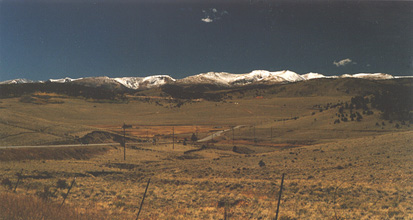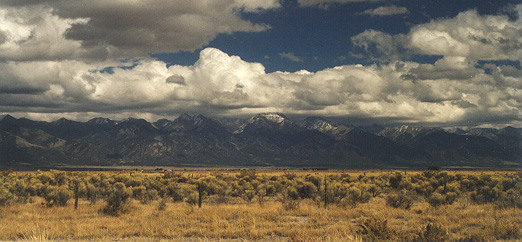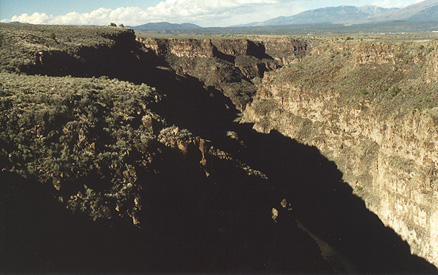

It was a day for great photographs; unfortunately the meter on my camera wasn't working, after just getting it back from the repair shop where they said nothing was wrong with the camera (and the meter worked before I took it in). So I used basic settings and bracketed…ignoring the automatic shutter speed option. I'm so used to manual settings that I ignore automatic unless Kaitlynn wants to take pictures or I use the flash. Well, the bad news is that, out of 120 shots, I got about twelve worth looking at.
I was playing a tape of Clarissa Pinkola Estés talking about "Creative Fire." She is the author of Women Who Run With The Wolves, which I've partially read but never finished. Dixie Clarke of the artists' group loaned me this tape at least eight months ago, and it sat on the edge of the dining table ever since, unlistened to, until I put it in the car for the trip.
Estés' retelling of the myth of Demeter and Persephone in her soft, clear voice rolled with me across the wide stretch of South Park. At the western side, I dropped down through a small canyon which opened out into a valley running between Buena Vista and Salida. As I wound down, Estés began telling a Russian folkstory about the corpse bride.
A bridegroom and his friends are on the way to his wedding. They break their trip for a meal beside a river. After eating and resting, the groom notices a twig sticking out of the earth. He takes his bride-to-be's ring and places it on the twig, and in doing so, sees that it is a fingerbone. Still, he begins singing the wedding song and dancing around the ringed bone three times.As I listen, I know that this is magic and he will be caught in some manner.
Sure enough, the ground breaks open and a woman skeleton, clothed with the mouldering remnants of her wedding dress, assembles and stands and demands of the groom her wedding night.
As I come to the stop sign where I turn south, directly in front of me are Mount Princeton and other fourteen-thousand foot peaks lining the western side of this valley. Bits of snow lie on their rock ledges.
The groom and his friends race to the village where his bride and the rest of the wedding party await. The corpse bride wearing the ring comes trailing after, arriving and again demanding her wedding night. The groom takes his dilemma to the rabbis assembled for the wedding. After much pulling of all the particulars from the groom, such as the wedding dance three times around the ringed fingerbone, the rabbis reach a decision: the dead have no claim on the living.With that pronouncement, the corpse bride collapses, crying out for her lost dreams. And the living bride, who has been in shock and horror-struck, comes forth and cradles the tattered-clothed skeleton and, with deep compassion, promises to embody in her marriage the dreams of the corpse bride and her own. With that promise, the corpse bride retreats to her grave beside the river.
I ascended Poncha Pass, a low divide which lifts gently to the north end of the San Luis Valley, an exceedingly broad valley well known for its many farms of fruits and vegetables, which have suffered greatly with this year's drought.
Estés continued by telling how the folktale sprang from the story of Russian natives attempting to keep the Jewish population in check by ambushing and killing wedding parties, in particular, to kill the bride, the fruitful symbol of children to come. The murdered people were buried where they fell.
For Estés, the story symbolized the necessity of being compassionate toward your dreams, your hopes, your ideas, your work, your loves. To give them breath and life by allowing them to be and not to choke them off or put them down. That it is through compassion for our creative selves that we enrich and embolden our inner fire.
Route 285 paralleled the Sangre de Cristo mountains as they stretch out along the east side of the San Luis Valley. Sagebrush filled the foreground and ranches seemed distant at the end of narrow dirt roads.

I reached the point where 285 curved west and Route 17 went straight south and I turned to take the short-cut to Alamosa: 50 miles without hardly moving the steering wheel. Shortly after the turn, a field appeared that had tipis and yurts and near the road was a sign that announced "Joyful Journeys Hot Springs Spa." Joyful journeys instantly resonated. August 1998 I wrote a poem and posted it in "Thoughts of a Seeker":
And I keep thinking that I want to live in a yurt. A round space. With skylights. Yes, indeed, yurts and joyful journeys resonated. But I had miles and miles to go and didn't stop to find out why they named their place Joyful Journeys. Another time.OF GODS AND QUESTIONS
If you have asked the eternal why,
And listened to the stars
Breathe their answers on the wind
If you have whispered in the dark night
And felt the inner workings of your soul
If you have stroked your fingers
On the soft fuzz of mullein leaf
And the hard planes of quartz
If you have experienced one
Awe-gathering moment of bliss
When the Universe was in you and around you
Then you are living the question,
remembering who you are
and determining who you are not.
That is truly what we are all about
On this journey of joy
I got back on 285 south of Alamosa, rising higher as the land swelled up to the Colorado-New Mexico border. A mounded hill rose high above the road, where four or five houses were tucked into a crease of the hillside, looking out across the lonesome and wide open viewspace to the distant Sangre de Cristos.
The cumulus clouds were eased of some rain near the mountains, and before I got to Santa Fe, I saw two rainbows pouring from the clouds. I considered seeing them, as I was nearing the new home of a co-worker, blessings for her. It all ran together: Clarissa Pinkola Estés and creative fire, rainbows, an inspiring place for my friend to work in and recreate in — Santa Fe — that city of rich red-brown adobe, where curves and rounded edges create a soft and eye-resting aura.
(P.S. On the way home, I missed 285's swing to the left and found myself traveling the road to Taos, didn't stop though. On the road that reconnected me to 285, I crossed the Rio Grande Gorge, where water gleamed very faintly in the depths of the canyon.)

Another reason I took this quick trip was to get a break from the awfulness of what was happening in the national halls of the United States government. It was a brief respite, to be sure.
Just because our insecure-minded leaders have taken this step (the Congress approved the resolution authorizing the President to order pre-emptive strikes), doesn't mean that we who feel this resolution is a grievous mistake should just shut up and mind our business. The possible murder of Iraqi civilians by our military together with the possible great loss of life and good health by our own service men and women is at stake. Nobody is mentioning how many body bags will or have been ordered.
How much Uranium 238 (depleted uranium) (see Helen Caldicott's recent posting on Common Dreams) dust will become residual in more Iraqi soil and in the bodies of Iraqi people and in the bodies of American service men and women, who will sicken and have significantly impaired health? Ask why over 200,000 of the 800,000 service men and women who served in Desert Storm have significant illnesses. Will it — whatever "it" really is, as in oil fields and the megalomaniacal hopes of Cheney, Rumsfeld, Wolfowitz,…and GW Bush — be worth the great amount of pain and suffering in the now and in the decades to come? Do we really want to set the ball rolling toward nuclear weapons being used by those who have them to get something they don't have? Think about it.
I've heard the spurious rhetoric of a man who presumes to be President of the United States. Compassion? Only toward people who are just like him. No, what I hear is the desire to make the United States the tyrant of the world, and since the U.S. has become a "corpocracy," run by the corporate megaliths of the globe, guess who will be the real tyrants. That does not create security.
We should be calling for our government to work with other nations to bring Hussein to an international court for crimes against humanity, even though it may cause the United States to also be named as aiders and abetters in the 1980s war between Iraq and Iran and Iraq and its Kurdish population for supplying biological and chemical agents used by Iraq to begin its program of bio/chem warfare.
I offer that when the United States puts its military budget allocation into the humanitarian aid slot, and vice versa, and works hard to be become the neighbor of the world instead of the corporate and military monster it is, then we will know what security really means. And the world would know it, too. And I am grateful for the honoring of former President Jimmy Carter with the Nobel Peace Prize.
In the United States, corporate-owned media takes a long time to air other views (and I include National Public Radio and the Public Broadcasting System in this category), if it even does so, unless you happen to live where there is a strongly progressive editorial board on your local newspaper. I wanted to make sure that you all know about the websites Common Dreams, and TruthOut, to go to for fresh reports on what's being said across the country and in other countries. If you haven't gone to alternative media sources for news, I strongly encourage you to do so.